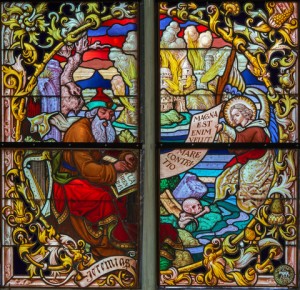
 Of all the genres of the Old and New Testament, the prophets stand out as some of the most intriguing and imagistic. They start out with the familiar pattern of “The word the Lord came to” and then it is anybody’s guess what happens from there.
Of all the genres of the Old and New Testament, the prophets stand out as some of the most intriguing and imagistic. They start out with the familiar pattern of “The word the Lord came to” and then it is anybody’s guess what happens from there.
Ezekiel features the image of a valley of dry bones snapping into life, resurrected and gift-wrapped with flesh. Where else in the Bible can one find an image so akin to The Walking Dead? Ezekiel also features an inaugural image involving four creatures, each a mass of faces and wings. This is the “wheel within intersecting wheel” passage. The book is also the source of the trope of Lucifer cast out of heaven, like a spear to the earth, a snapshot repurposed by authors like William Blake.
God asks Isaiah to put a live coal in his mouth, purifying his speech in a highly symbolic text. God then commissions the prophet to go and speak to a people that will not hear with words that they will not understand (sounds like bus duty to a public educator). Most people like to quote the part where Isaiah says, “Here I am, send me!” Churches love this verse because they can print it on banners and use it to start building programs, inspire mission trips, and sell hotdogs at the local welcome center.
What they fail to cite is the following passage about how Isaiah’s message is one that will be ignored, and that this journey will continue until everything is ruined, deserted, forsaken, and ravaged. It is easy to see why these words do not make it onto the banner. The commission concludes with God saying, “the holy seed will be a stump in the land” (Is. 6:13). Now, that is reassuring. Words like stump do not sell hot dogs.
Then there are the other tasks that the prophets are assigned. Isaiah gets to walk around in the buff, Ezekiel cooks his food over excrement, Daniel gets to spend time in a lion’s den, Hosea marries a prostitute, Joel uses locusts as a prophetic device, and Jeremiah laments…a lot.
The message presented against the backdrop of these odd actions is usually similar. It goes something like, “The people are doing wrong, punishments will come unless the people turn, and mercy will be given to them if they repent.” It is like hubris, ate, nemesis, with much more emphasis on grace.
This dichotomy is so strong in the book of Isaiah that some scholars insist there are two authors. The first part of the book deals with Isaiah’s original commission under the reign of King Hezekiah. Hezekiah then invites a Babylonian entourage to tour the kingdom (hint, wink: bad idea, coming invasion), and the second part of the book features a pissed off Isaiah prognosticating about events that will happen far into the future. The transition really occurs at Isaiah chapter thirty-nine.
What particularly works in some of the prophets, elevating them beyond a simple call to repentance, are those strange images and symbolic texts that cause the reader to look twice. It is easy to bog down in genealogies and lists of laws, but the section of the Old Testament devoted to prophecy is an entirely different matter.
The same could be said for the New Testament; the reader gets the same story told with essential accuracy in the first three synoptic gospels, with the Gospel of John telling the story from a different angle. Then the reader encounters a series of epistles in which various authors attempt to apply the events of the gospel narratives to situations encountered thereafter.
The book of Revelation sits at the edge of the New Testament like a road sign, with its heavy-handed images of the world melting like candle wax. The prophets seem to be the capstone genre, existing at the edge of the periphery. Once the history is told, the inevitable question is, what happens next?
The prophets answer that question with symbolism and strange characters, leaving the reader guessing still.
JD DeHart is a featured author in Sulfurings: Tales from Sodom & Gomorrah. He is the author of two collections, Decaf Days and Sunrise of Tomorrow, both available on Amazon.
Tags: Bible, JD DeHart, New Testament, Old Testament, prophets, stories